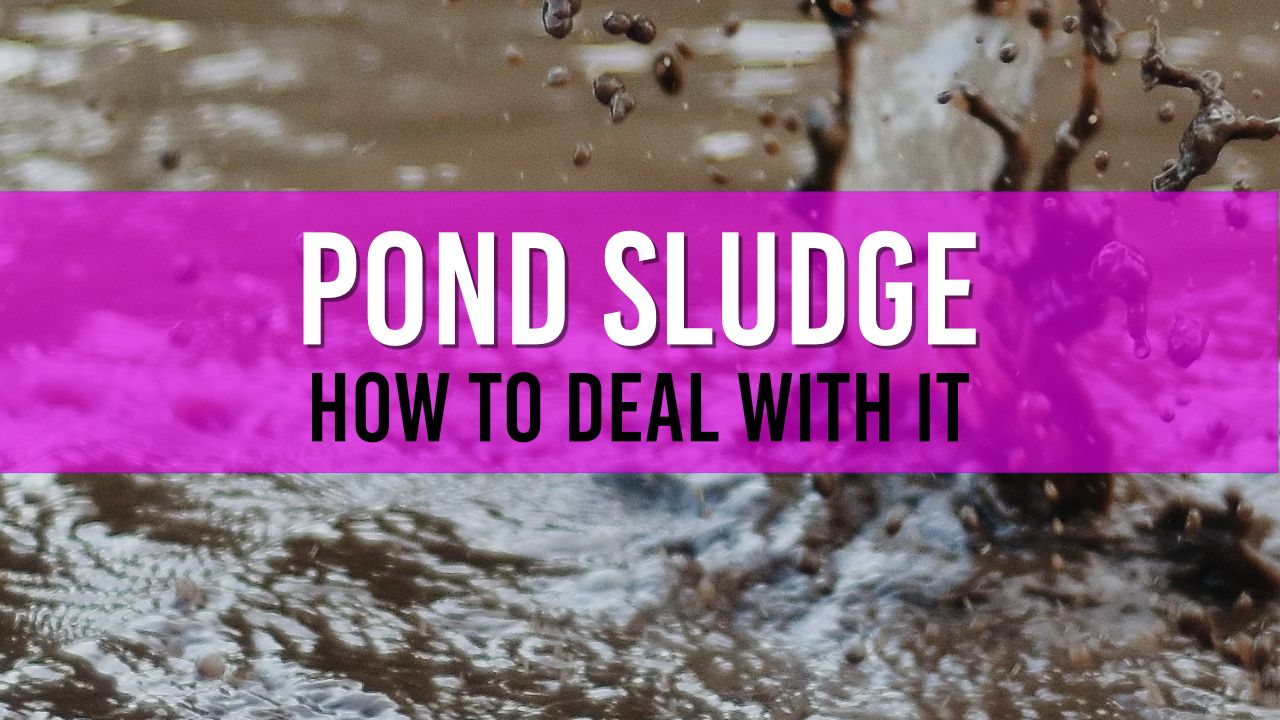How to Deal with Pond Sludge
A small amount of pond sludge is absolutely fine for garden ponds. Once your water begins to smell or becomes cloudy it's time to remove it. You can remove using a pond vac, by hand or by using pond sludge treatments.

Table of Contents
Pond sludge is a common issue faced by pond owners, and if left unchecked, it can lead to a variety of problems for your fish and plants. By maintaining a clean pond, you can ensure healthier fish, clearer water, and a more pleasant environment for you to enjoy.
In this article, I will discuss what pond sludge is, how to remove it, and how to prevent it from accumulating in the first place 👍
What is Pond Sludge?
Pond sludge, also known as pond muck, is a buildup of organic matter and debris that settles at the bottom of your pond. It is primarily caused by decaying plant material, fish waste, and uneaten fish food. There are different types of pond sludge, including:
What is Organic Pond Sludge?
Organic Pond Sludge is composed mainly of decaying plant matter and fish waste.
Possible Causes: Overfeeding, not removing dead leaves from pond plants.
What is Inorganic Sludge?
Inorganic Pond Sludge consists of sediment and dirt particles that have settled at the bottom of the pond.
Possible Causes: Dirt and Debris entering your pond.
Both types of sludge can negatively impact the health of your fish and plants by depleting oxygen levels and releasing harmful gases.
How to Remove Pond Sludge
There are 3 main methods to remove pond sludge:
Pond Vacuum to remove Pond Sludge
A pond vacuum (or pond vac) is a specialized tool designed to remove sludge from the bottom of your pond. Here's how to use one:
- Set up the pond vacuum according to the manufacturer's instructions.
- Begin vacuuming the pond by slowly moving the vacuum head across the bottom of the pond, sucking up sludge as you go.
- Dispose of the collected sludge in an appropriate location, such as a compost pile or in a designated area in your garden.
Pond Sludge Treatment
Sludge treatments are chemical or biological products designed to break down pond sludge. To use a sludge treatment:
- Choose a sludge treatment suitable for your pond size and type.
- Follow the manufacturer's instructions for dosage and application.
- Monitor your pond for any changes in water clarity and sludge levels, and reapply the treatment as needed.
Manual Removal removal of Pond Sludge
If you prefer a hands-on approach, you can manually remove pond sludge using a net or scoop. To do this:
- Put on gloves and appropriate protective gear (especially eye protection).
- Use a net or scoop to gently remove sludge from the bottom of your pond.
- Dispose of the collected sludge as you would with the pond vacuum method.
Preventing Pond Sludge
To prevent pond sludge from accumulating, consider the following tips:
- Perform regular pond maintenance, including removing dead plant material and excess fish food.
- Ensure proper filtration by using a suitable pond filter for your pond size and type.
- Maintain a healthy balance of fish, plants, and beneficial bacteria to prevent excess nutrients from building up and causing sludge.

Frequently Asked Questions
I have prepared some of the most popular questions relating to Pond Sludge, it's removal and prevention tips. If a questions/answer is not listed - please leave a comment below and I will update the list of questions.
How often should I remove pond sludge?
It depends on your pond size and the amount of sludge buildup. Generally, it's recommended to remove sludge at least once or twice a year, preferably during spring and fall.
Will removing pond sludge harm my fish?
If done carefully and properly, removing pond sludge should not harm your fish. However, make sure not to stress the fish by removing too much sludge at once or creating excessive disturbance in the water.
Can I use a regular vacuum cleaner to remove pond sludge?
No, a regular vacuum cleaner is not suitable for pond sludge removal. A specialized pond vacuum is designed to work in water and handle pond debris.
How do I know if my pond has too much sludge?
Signs of excessive sludge include poor water clarity, unpleasant odors, and difficulty in seeing the pond bottom. Regularly checking your pond's condition using water testing kits will help you determine if it's time to remove sludge.
Can I use pond sludge as fertilizer for my garden?
Yes, pond sludge can be used as a natural fertilizer for your garden. However, it's essential to ensure that the sludge does not contain harmful chemicals or pollutants before using it as fertilizer.
Is it necessary to remove all the sludge from my pond?
While removing all the sludge may not be necessary, it's crucial to maintain a balance. Leaving some sludge can be beneficial for the pond ecosystem, but too much can lead to water quality issues.
How can I prevent leaves from falling into my pond and contributing to sludge?
Installing a pond net or using a skimmer can help prevent leaves and other debris from falling into your pond and contributing to sludge buildup.
How do I know if my pond filter is effective at preventing sludge buildup?
Regularly check your pond filter for debris accumulation and ensure that it's properly functioning. A well-maintained filter should help prevent excessive sludge buildup.
Can pond sludge cause fish diseases?
Pond sludge can create an unhealthy environment for fish by depleting oxygen levels and releasing harmful gases, which can lead to stress and disease in fish.
How does pond sludge affect water quality?
Pond sludge can decrease water clarity, produce unpleasant odors, and affect the pond's oxygen levels, leading to poor water quality.
Can I use beneficial bacteria to help break down pond sludge?
Yes, adding beneficial bacteria to your pond can help break down organic matter and reduce sludge accumulation.
How do pond plants help reduce pond sludge?
Aquatic plants such as lilies can help reduce pond sludge by absorbing excess nutrients, providing oxygen, and offering a surface for beneficial bacteria to thrive.
Is it okay to remove sludge during winter?
It's generally best to avoid removing sludge during winter, as cold temperatures can make it more challenging and stressful for fish. Instead, focus on sludge removal during spring and autumn.
How can I tell if my pond sludge is organic or inorganic?
Organic sludge is usually soft, black or brown, and has an earthy smell, while inorganic sludge tends to be more dense and consists of sediment and dirt particles.
Can I use a pond liner to prevent sludge buildup?
While a pond liner can help prevent dirt and sediment from entering your pond, it won't prevent the buildup of organic sludge from plant decay and fish waste.
Can overfeeding my fish contribute to pond sludge?
Yes, overfeeding your fish can lead to uneaten food settling at the bottom of the pond, which contributes to sludge buildup. To prevent this, feed your fish only the amount they can consume within a few minutes.
How does aeration help reduce pond sludge?
Aeration increases the oxygen levels in your pond, which promotes the growth of beneficial bacteria that break down organic matter and reduce sludge accumulation.
Can I use pond dye to reduce sludge buildup?
While pond dye won't directly reduce sludge buildup, it can help by blocking sunlight and inhibiting the growth of algae, which contributes to sludge when it dies and decays.
Should I remove pond sludge before adding new fish?
It's a good idea to remove excessive pond sludge before adding new fish to ensure a healthy environment. Some sludge is beneficial for maintaining a balanced ecosystem, so aim to strike a balance rather than removing all sludge from your pond.
Conclusion
Pond sludge can be a major issue for pond owners, but by understanding its causes and following the methods outlined in this article, you can effectively remove and prevent it from accumulating.
In summary, here are the steps to take for successful pond sludge removal:
Steps 'at-a-glance' to Remove Pond Sludge:
- Choose a method: Select a pond sludge removal method that suits your needs, such as using a pond vacuum, applying sludge treatment, or manually removing the sludge.
- Follow instructions: Ensure you follow the step-by-step instructions for your chosen method, using the necessary equipment and precautions.
- Monitor your pond: Keep an eye on your pond's condition, including water clarity and sludge levels, and remove sludge as needed.
Remember, a clean, healthy pond is crucial for the wellbeing of your fish and plants, so don't hesitate to take action and maintain a balanced ecosystem in your pond.


